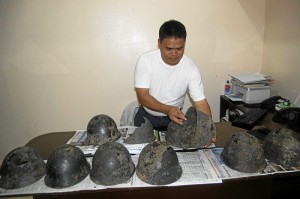Old helmets found, but war tale missing

DIGGING FIND Joselito del Rosario, chief of the Public Safety Office in Naga City, shows the helmets believed to be worn by Japanese soldiers in 1945. JUAN ESCANDOR JR.
NAGA CITY—Diggers have unearthed a World War II story puzzle in Naga City after 21 rusty Japanese military helmets with bullet holes were found in a drainage canal project near the Metropolitan Naga Cathedral last week.
Were the helmets worn by Japanese soldiers during fierce fighting with Filipino guerrillas or did the soldiers simply throw the metal headgear away when they decided to flee with light load from pursuers?
“Definitely,” Mayor John Bongat said, the war relics “will help us define history, especially during the Japanese period.”
The old, steel helmets were dug up Wednesday at a drainage construction site on I. Barlin and Dimasalang Streets. According to Jojo Ojeda, an engineer of the private firm undertaking the project, the helmets were found at a depth of more than one meter in one area.
Most of the helmets, however, were taken home by workers and passersby. Ojeda himself took one but turned it over to a representative of the city government who went to the site.
Bongat wondered what the significance of the location could be and why the helmets have holes.
They could have been pierced by Garand or Springfield bullets, SPO4 Arthur Matos, a city police investigator, said after examining two of the helmets and the size of their holes.
Jose Barrameda, a local historical researcher and author of the book “In The Crucible of An Asymmetrical War in Camarines Sur 1942-1945,” also examined the helmets and said these belonged to Japanese soldiers.
Barrameda said the helmets could have been punctured by bullets fired from high-powered rifles, possibly Garand, but dismissed the theory that these might have been worn in battle.
“I have no definite proof, but I am almost certain that those helmets were discarded in the morning of April 9, 1945, the liberation of Naga City,” he said.
He inferred that the Japanese soldiers were fleeing from the Tangco Vaca guerrillas who were laying siege on the Japanese garrison at Ateneo de Naga College, about 150 meters from where the helmets were found.
“Because the Japanese soldiers were fleeing, they discarded their heavy helmets in that place which were found later by pursuing guerrillas. Out of anger and frustration because the Japanese had fled, the guerrillas resorted to just peppering the helmets with their new firearms which were air dropped by American planes,” he surmised.
Matos asked the workers to turn their find over to the city government for proper inventory as these could be considered part of the city’s historical artifacts.
On Friday, nine helmets and two helmet fragments were received by the city government, according to Joselito del Rosario, chief of the Public Safety Office. He said his office would be the custodian until the city government decides where to entrust the military artifacts.